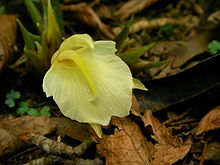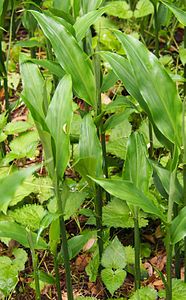Myoga: Difference between revisions
Davidcannon (talk | contribs) m clean up; Took out stray bracket using AWB |
|||
| Line 31: | Line 31: | ||
== Medicinal properties == |
== Medicinal properties == |
||
Some constituents of myoga are [[Cytotoxicity|cytotoxic]]; others have shown promise for potentially [[Carcinogen|anticarcinogenic]] properties.<ref>Ha Won Kim ''et al.'' [http://www.liebertonline.com/doi/pdf/10.1089/ars.2005.7.1621 "Suppressive Effects of Mioga Ginger and Ginger Constituents on Reactive Oxygen and Nitrogen Species Generation, and the Expression of Inducible Pro-Inflammatory Genes in Macrophages,"] ''Antioxidants & Redox Signaling.'' November/December 2005, 7(11-12): 1621-1629; retrieved 2013-8-4.</ref> |
Some constituents of myoga are [[Cytotoxicity|cytotoxic]]{{which}}; others have shown promise for potentially [[Carcinogen|anticarcinogenic]] properties.<ref>Ha Won Kim ''et al.'' [http://www.liebertonline.com/doi/pdf/10.1089/ars.2005.7.1621 "Suppressive Effects of Mioga Ginger and Ginger Constituents on Reactive Oxygen and Nitrogen Species Generation, and the Expression of Inducible Pro-Inflammatory Genes in Macrophages,"] ''Antioxidants & Redox Signaling.'' November/December 2005, 7(11-12): 1621-1629; retrieved 2013-8-4.</ref> |
||
==Gallery== |
==Gallery== |
||
Revision as of 10:16, 6 March 2016
| Myōga | |
|---|---|

| |
| Scientific classification | |
| Kingdom: | |
| (unranked): | |
| (unranked): | |
| (unranked): | |
| Order: | |
| Family: | |
| Genus: | |
| Species: | Z. mioga
|
| Binomial name | |
| Zingiber mioga | |
| Synonyms[1] | |
| |
Myoga, myoga ginger or Japanese ginger (myōga (茗荷)) is the species Zingiber mioga in the Zingiberaceae family. It is a deciduous herbaceous perennial native to Japan, China, and the southern part of Korea.[1][2][3] Only its edible flower buds and flavorful shoots are used in cooking.[4] The flower buds are finely shredded and used in Japanese cuisine as a garnish for miso soup, sunomono, and dishes such as roasted eggplant. In Korean cuisine, the flower buds are skewered alternately with pieces of meat and then are pan-fried.
Cultivation
A traditional crop in Japan, myoga ginger has been introduced to cultivation in Australia and New Zealand for export to the Japanese market.[3]
As a woodland plant, myoga has specific shade requirements for its growth. It is frost-tolerant to −16 °C (3 °F), and possibly colder.[3]
Three variegated cultivars are known: 'Dancing Crane', 'Silver Arrow' and 'White Feather'. They are less cold-hardy than unvariegated plants.[3]
Medicinal properties
Some constituents of myoga are cytotoxic[which?]; others have shown promise for potentially anticarcinogenic properties.[5]
Gallery
-
Plants
-
Fruits with red interiors and black seeds with a whitish aril
-
Buds prepared for sale
References
- ^ a b Kew World Checklist of Selected Plant Families
- ^ Flora of China v 24 p 332, 蘘荷 rang he, Zingiber mioga (Thunberg) Roscoe, Trans. Linn. Soc. London, Bot. 8: 348. 1807.
- ^ a b c d Cole TCH, Nürnberger S "Zingiber mioga and its Cultivars," The Plantsman. Royal Horticultural Society. December 2014, 4: 226-229.
- ^ Matsuhisa, Nobu and Mark Edwards. (2007). Nobu West, p. 252.
- ^ Ha Won Kim et al. "Suppressive Effects of Mioga Ginger and Ginger Constituents on Reactive Oxygen and Nitrogen Species Generation, and the Expression of Inducible Pro-Inflammatory Genes in Macrophages," Antioxidants & Redox Signaling. November/December 2005, 7(11-12): 1621-1629; retrieved 2013-8-4.



